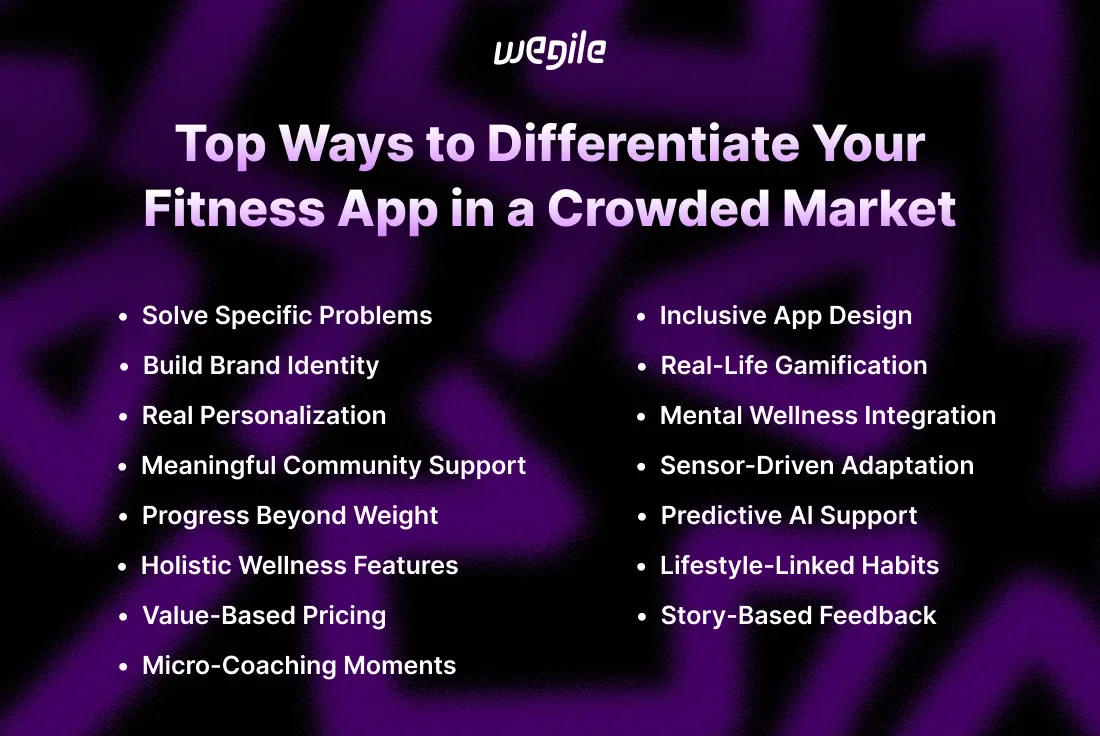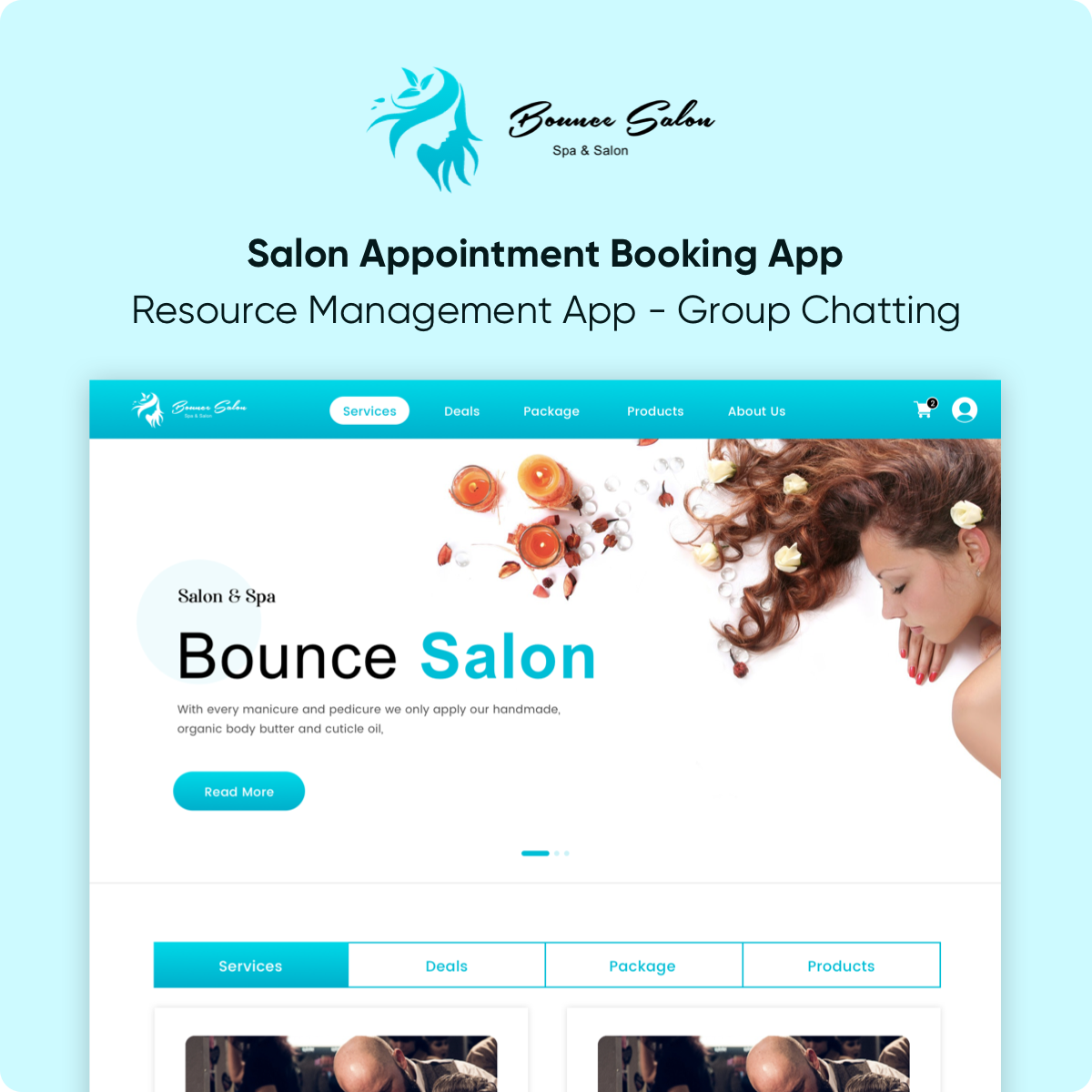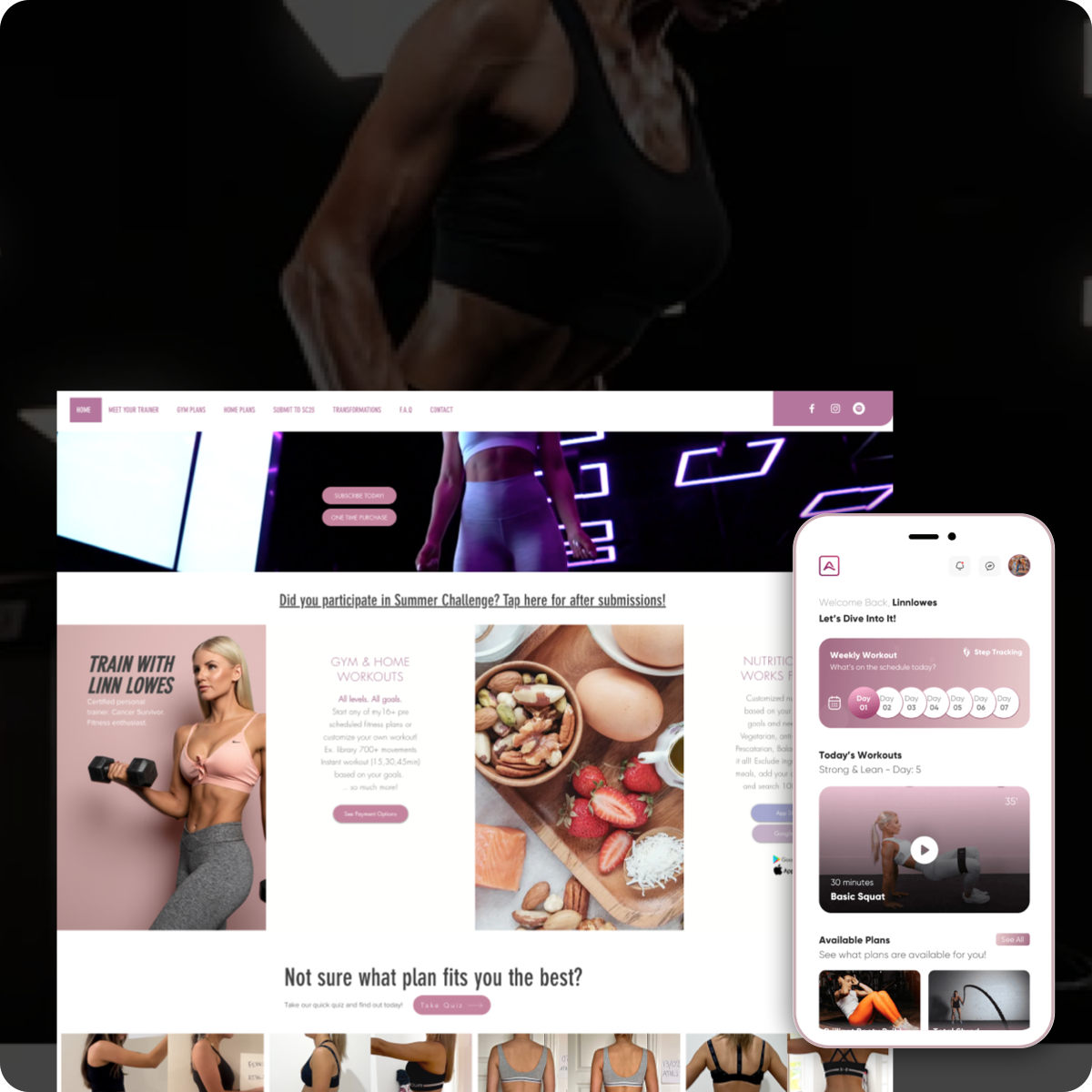The global fitness app market size was precisely valued at USD 2.10 billion in 2024 and is all set to reach from USD 2.47 billion in 2025 to USD 9.67 billion by 2033, stupendously growing at a CAGR of 18.2% during the stated forecast period
Well, the digital fitness space continues expanding as user behavior shifts toward mobile-first, personalized health and wellness experiences. If your app is just another tracker, timer, or step counter, it will disappear under noise. Users are flooded with hundreds of apps promising similar workouts, calorie plans, and transformation tips, which means differentiation is no longer about functionality alone. You must offer something deeper, something that resonates with user behavior, goals, and unmet expectations.
In this section, we explore exactly how your fitness app can create that kind of resonance and stand out where others look interchangeable.

Many fitness apps fail to differentiate because they try to appeal to everyone and end up exciting no one. General messaging like “get fit” or “build strength” gets lost in the crowd because users are looking for targeted solutions, not vague aspirations.
Your fitness app should address a very specific user pain point. For example, instead of creating a “workout for everyone” app, focus on postpartum recovery, marathon prep, or high-altitude endurance training.
When the app speaks directly to the unique journey of a specific audience, it no longer competes with every other general-purpose product. Success begins when your app defines the user's need clearly and solves it better than any broader tool.
Fitness is emotional and deeply tied to how users feel about themselves, not just how they move. If your app does not build a brand people want to engage with, then it risks becoming a utility that gets uninstalled when motivation drops.
From your logo and color palette to the welcome messages and progress screens, everything must feel intentional. The tone of your notifications, the language in your tutorials, and the rewards after milestones should reinforce a voice that users recognize and trust. First impressions matter deeply, but sustained emotional consistency keeps users from switching when a competitor offers something newer. Fitness routines fluctuate, but emotional loyalty builds through consistent brand tone that adapts to user life rhythms.
Users are no longer impressed by basic personalization like inserting their name or age into workout recommendations. They expect apps to understand how their mood, energy, schedule, and previous sessions impact what they can do today.
Instead of offering a static plan based on weight and age, allow dynamic adjustments based on feedback. If the user logs low energy, offer a recovery session. If the user skips a planned workout, update the schedule without shame-driven messaging. The goal is to make the app feel like a personal coach who listens, not just a robot assigning tasks. Effective personalization builds when every interaction adapts to the evolving nature of the user's fitness story.
Many apps now include a “community” tab but few use it meaningfully. A real fitness community is not just another comment feed, it is a reflection of user identity, motivation, and shared milestones.
Instead of open-ended forums, build structured conversations around challenges, goals, or themes. For example, users completing a 21-day strength challenge could be placed into micro-groups that track progress together.
Allow peer encouragement, coach messages, and milestone celebrations in ways that feel real instead of performative. A strong community reduces churn because users feel like they are seen, supported, and part of something real.
Too many apps focus only on weight loss or calorie burn, which limits the sense of achievement. Users now seek a fuller picture of progress including strength, recovery, energy, and habit consistency.
Use timelines that show how frequently users completed workouts or reflect improvements in mood, hydration, or sleep. Even if the weight remains the same, showing habit graphs helps users stay motivated. When your app reflects invisible victories, users stick with it during physical plateaus.
Progress feels more powerful when measured in behavior, consistency, and lifestyle, and not just inches or pounds.
Differentiation grows when your app becomes more than just a space for exercise. If it supports the user’s full wellness rhythm, then the app becomes a daily tool instead of a once-a-day workout platform.
Offer features that let users log sleep quality, stress levels, hydration, or energy. Add guided reflections that help users journal how they felt after workouts. Suggest routines that help with winding down, not just powering up.
This type of holistic fitness builds habit strength that reduces uninstall risk and improves daily engagement metrics.
In crowded markets, pricing is not always a race to the bottom. If users feel that the app truly supports their transformation journey, then they will not switch based on a few rupees or dollars.
Instead of a generic 7-day trial, allow users to unlock free features by completing their first full week of workouts. Reward consistency with access to advanced sessions. When users earn features through habit formation, they associate payment with progress, not with pressure.
Pricing becomes sticky when it connects with emotion, reward, and visible transformation instead of arbitrary time periods.
Users want structure, but they also crave guidance that feels expert-driven and human, and not just algorithmic. Most fitness apps rely on pre-recorded routines or static text advice that feels disconnected from real coaching.
When a user misses multiple workouts, fails to complete a session, or appears inconsistent, trigger short video or audio check-ins from real trainers. These should not be generic motivational quotes, but brief, actionable insights that feel personal. You can also surface coach tips between sets, transitions, or cool-downs to improve form or mindset.
This real-time micro-coaching provides mentorship at scale and transforms passive apps into guided ecosystems of support.
Fitness is not one-size-fits-all as many users feel left out when routines assume athletic mobility, youth, or body symmetry. Differentiation grows when your app includes people who feel ignored by mainstream platforms.
Include seated workouts, mobility-based flows, and sensory-friendly UI options. For users managing chronic pain or post-injury rehab, create low-impact plans with daily adjustments. Visually impaired users benefit from voice guidance that describes transitions clearly, not just music cues. Neurodivergent users may appreciate simplified layouts that reduce over-stimulation.
By designing for inclusion from day one, your app shows it was built for real people with real lives, not just ideal users.
Many fitness apps reward streaks or leaderboards, but they often feel disconnected from daily reality. Users do not always compete with others, they compete with their own schedules, moods, and stress.
If the user logs a stressful day or poor sleep, offer a “reset quest” focused on movement and recovery. During public holidays or travel periods, create missions like “hotel room circuit” or “10-minute mobility between flights.” Let users choose short-term goals that make sense for their calendar, mood, or environment.
When gamification honors real-life rhythms, it becomes motivational instead of pressure-filled.
Users often quit fitness routines not because they lack time, but because they feel overwhelmed. Physical wellness does not exist in isolation, and your app becomes more valuable when it treats mental recovery as essential, not optional.
Include sessions designed to reduce anxiety, improve post-workout mental clarity, or promote pre-bed relaxation. These should live alongside workouts, and not hidden in a separate tab, so users build a habit of balancing mental and physical exertion. Allow users to track how emotional energy changes alongside physical gains.
When your app supports both the body and the mind, users stay engaged even during emotionally difficult weeks.
Users are no longer satisfied with static workouts that fail to adapt in real-time to their physical state. Differentiation today lies in how quickly your app reads and responds to real-world data, especially through connected devices and wearables.
Integrate with devices that monitor heart rate, oxygen levels, or motion to adapt routines in real-time. For example, if a user's heart rate exceeds target thresholds, the app should suggest a rest period or adjust the pace.
If the user stays below minimum intensity, offer instant coaching or switch formats. This kind of response shows the app understands not just preferences but also biological signals. An app that adjusts workouts based on sensor data builds a reputation for listening, not just instructing.
Fitness goals often derail not because of lack of effort but because of inconsistent support at the right time. While most apps recommend static routines, your app can stand apart by predicting user behavior using real contextual data powered by AI.
By combining daily usage history, sleep logs, skipped days, and mood reflections, fitness AI models can forecast when a user is likely to break consistency. For example, if someone tends to skip workouts after three consecutive late nights, the app can proactively shift their plan or offer a shorter session to maintain rhythm.
You can also recommend alternate formats when users show repetitive logging patterns that indicate boredom. Predictive AI turns your app into a coach that does not wait for problems, it prevents them before they arise.
This predictive intelligence changes your product from reactive to supportive, which deepens trust and long-term retention.
Most fitness apps track activity in isolation, which makes it harder for users to build lasting behavioral change. Differentiation grows when your app connects physical movement to the user’s broader lifestyle in a personalized loop.
Use app integrations, calendar inputs, or self-reported insights to identify patterns between lifestyle and fitness behavior. For instance, if the user sleeps better after yoga or reports stress relief after an evening walk, surface those connections inside the app. Remind them of these positive links during low-motivation periods. When your app reflects life beyond reps or sets, it becomes a trusted lifestyle guide instead of just another workout tool.
When behavior and outcome feel connected, habits form more easily, and loyalty follows without extra nudges.
Users often struggle to stay motivated when they cannot interpret the numbers the app throws at them. Showing calories burned or minutes completed without narrative context leaves people feeling either confused or disconnected.
Instead of only showing raw metrics, translate data into short, story-like reflections. For example, after five days of consistent walking, show a message that says, “You’ve now walked farther than the distance between India Gate and Rashtrapati Bhavan.” These reference points turn invisible metrics into memorable, relatable progress moments.
Also, let users scroll through past stories and revisit the journey like a personal timeline. Progress becomes emotional, not just numerical, when the language reflects personal growth in real-world terms. Fitness apps that tell meaningful stories keep users inspired long after the
In a market where fitness apps compete for the same swipe and attention span, differentiation must start early and go deep. You cannot win by copying formats or chasing trends. You stand out when you show the user that this app was built for them, not for everyone.
When you solve a focused problem, speak in a consistent voice, deliver real adaptation, and support full wellness, and not just workouts, then your app earns space in the user's life.
Always remember that differentiation is not a feature; it is a philosophy that turns your fitness product into a trusted companion for change.


 Browse Our Services
Browse Our Services
